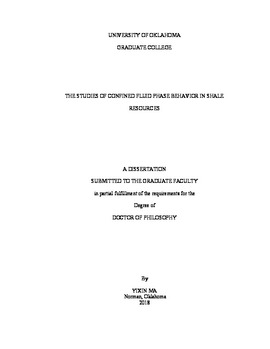| dc.description.abstract | Fluid phase behavior in porous media is governed by not only fluid-fluid interactions but also fluid-wall interactions. In shale formations, a large amount of hydrocarbon fluid is stored within the organic matters where the pore sizes are in the order of nanometer scales. Inside these nanopores, the interactions between the fluid molecules and porous walls play such an important role that can change the fluid physical properties of the stored hydrocarbons.
The first part of this work is to focus on investigating the effects of pore proximity in shale formations on phase behavior of the reservoir fluids by modifying the cubic equations of state (EOS), e.g. van der Waals EOS and Peng-Robinson EOS. Effects of both fluid-fluid and fluid-wall interactions are included in the modified EOS. Such effects were averaged for any particular pore sizes. Correlations based upon the available molecular simulation results were developed to include the effects of fluid-wall interactions into the modified EOS. The relationships between the binary interaction coefficients and pore sizes of a C1/nC5 binary mixture were obtained based on experimental data using modified Peng-Robinson EOS. The vapor-liquid equilibrium (VLE) calculations were performed on a C1/nC4/C10 ternary mixture using the modified Peng-Robinson EOS. The results showed that smaller pores caused the fluid mixture to behave similar to dry gas, which results in reduction in condensate banking and delay in condensate dropout during production in comparison to conventional reservoirs.
Although the fluid phase behavior was calculated based on an average point of view for different pore sizes. It is believed that the fluids inside the nanoscale pores are notuniformly distributed due to the fluid-wall interactions. The fluid density is higher near the wall than the center region of the pore. The second part of this work is concentrated on obtaining the fluid density profiles across the pore. The fluids in nanoscale pores were considered to form bulk phase, transition phase and adsorbed phase depended on the distances to the pore walls. Simplified Local Density (SLD) theory coupled with the modified Peng-Robinson EOS was used to calculate the density profiles for both single- component fluids and mixtures in different pore sizes. Both the fluid density profiles of single component fluids (e.g. methane, ether, propane and n-butane) and binary mixtures were investigated using the SLD-PR model. The results showed that the fluid density near the wall is much higher than that in the center of the pore. On the other hand, pressure, temperature, pore size, fluid type and fluid composition all have impacts on the fluid distributions. Higher pressure can shift the fluid density profile to a higher value while increase in temperature can shift down the density profile. For heavy components, such as n-butane, the adsorbed region is larger than that for light components, such as methane. For fluid mixtures, the composition of the fluid changes across the pore and the composition of the heavier component is much higher close to the pore compare to the bulk fluid.
The third part of this work is the application of the SLD theory to couple with a new Gas- In-Place (GIP) model on a case study of predicting the phase behavior of real reservoir fluids in condensate window of Eagle Ford shale and estimating the adsorbed gas content and the total GIP of the reservoir at high temperature and pressure. The preliminary computation results showed that the adsorbed gas could take more than 30% of gas in place in Eagle Ford shale. By using the introduced method, the adsorbed gas content and
xviii
the total GIP in unconventional reservoirs were calculated with good accuracy under short computational time. This makes the model useful when implemented into reservoir simulators.
The fourth part of this work investigates the occurrence of capillary condensation inside nanoporous shales and the way to quantify the condensed fluid contents and the behaviors using the SLD model combined with modified Young-Laplace equation. It is the first attempt to quantitatively consider both adsorption and capillary condensation for hydrocarbon mixtures in shale media. For a retrograde mixture, the effects of capillary condensation reduce the lower dew point pressure and increase the upper dew point pressure. The shift is larger for the lower dew point pressure. This finding is consistent with the results calculated using the modified EOS to consider the pore size effects in the first part of this dissertation, which gives a cross-validation to both models.
The last part of this dissertation work focuses on molecular dynamic (MD) simulations of hydrocarbons in nanopores. A universal molecular simulator called LAMMPS is used to perform MD simulations of hydrocarbon mixtures. From these MD simulations, we are able to investigate how hydrocarbon fluids are arranged under the effects of the pore wall. The results show that the pore wall attracts hydrocarbon molecules to form a high- density adsorbed region. This agrees with the findings from SLD model described in previous chapters. | en_US |
